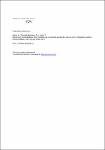Minimising contributions from scattering in infrared spectra by means of an integrating sphere
Dazzi, Alexandre
Deniset-Besseau, Ariane
Lasch, Peter
Mid-infrared spectra of biological matter such as tissues or microbial and eukaryotic cells measured in a transmission-type optical setup frequently show strongly distorted line shapes which arise from mixing of absorption and scattering contributions. Scattering-associated distorted line shapes may considerably complicate the analysis and interpretation of the infrared spectra and large efforts have been made to understand the mechanisms of scattering in biological matter and to compensate for spectral alterations caused by scattering. The goals of the present study were two-fold: firstly, to get a deeper understanding of the physics of scattering of biological systems and to explore how physical parameters of the scatterers such as shape, size and refractive index influence the line shape distortions observed. In this context, simulations based on the full Mie scattering formalism for spherical particles were found to be useful in explaining the characteristics of the Mie scatter-associated distortions and yielded a size criterion for the scattering particles similar to the well-known near field criterion. The second objective of the study was to investigate whether alternative optical setups allow minimisation of the effects of scattering. For this purpose, an optical system is proposed which is composed of an integrating sphere unit originally designed for diffuse reflection measurements, an off-axis DLaTGS detector to collect scattered and transmitted light components and a commercial Fourier transform infrared (FTIR) spectrometer. In the context of this study transmission type (tt-) FTIR spectra and spectra acquired by means of the integrating sphere setup (is-FTIR) were acquired from monodisperse poly(methyl) methacrylate (PMMA) microspheres of systematically varying sizes. The tt-FTIR spectral data of different PMMA particles confirmed earlier observations such as the presence of size-dependent oscillating spectral baselines, peak shifts, or derivative-like spectral line shapes. Such effects could be dramatically minimised when is-FTIR spectra were acquired by the integrating sphere unit. Utilisation of an integrating sphere is suggested as a convenient and easy-to use alternative to computer-based methods of scatter correction.
Dateien zu dieser Publikation
Keine Lizenzangabe

